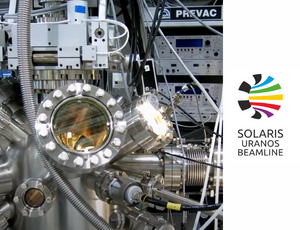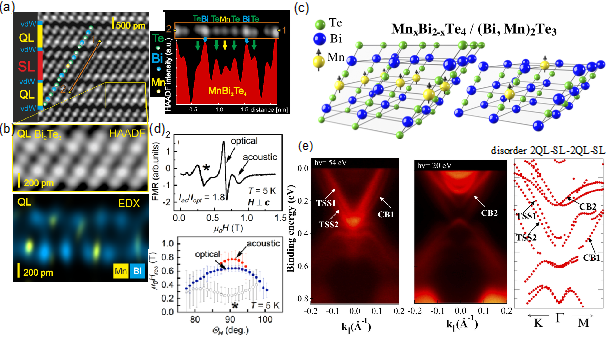
 Web Content Display
Web Content Display
SOLARIS centre
 Web Content Display
Web Content Display
 Web Content Display
Web Content Display
The systemic consequences of disorder in magnetically self-organized topological MnBi2Te4/(Bi2Te3)n superlattices

In a recent publication in 2D Materials, users of SOLARIS Centre highlight the critical importance of different disorder metrics in a new platform for quantum anomalous Hall (QAH) effect, MnBi2Te4/(Bi2Te3)n self-organized magnetic topological insulator. The material has recently been attracting increasing attention also as a perspective for axion-insulator phase. A major part of the study has been conducted using the angle-resolved photoemission spectroscopy beamline (URANOS, former UARPES) at Synchrotron SOLARIS.
Magnetic Topological Insulators
Joanna Sitnicka, the PhD student at the Faculty of Physics, University of Warsaw, and the first author of the publication is summarizing the main findings in the publication for us:
We studied the family of intrinsic magnetic topological insulators MnBi2Te4/(Bi2Te3)n. The materials structure is an alternating sequence of magnetic MnBi2Te4 seven-layers (SLs) and Bi2Te3 five-layers (QLs) (Fig. 1(a)). We performed structural and chemical composition analysis of ferromagnetic samples of MnBi2Te4/(Bi2Te3)n, with a few different distances n between adjacent SLs and correlated them with magnetic properties studied by ferromagnetic resonance spectroscopy (FMR) and with properties of electronic surface band structure investigated by angle-resolved photoemission spectroscopy (ARPES). Our structural analysis revealed disorder effects in a form of Mn substituting Bi in QLs and Mn missing in SLs (Fig. 1(b)). Such migration of Mn between SLs and otherwise non-magnetic QLs, which is schematically shown in Fig. 1(c), has systemic consequences for the material. It induces ferromagnetic coupling of Mn-depleted SLs with Mn-doped QLs, which is seen in FMR as an acoustic and optical resonance mode of the two coupled spin subsystems (Fig. 1(d)). It also strongly influences the surface band structure. ARPES measurements compared with density functional theory studies show that Mn disorder within an SL leads to delocalization of electron wave functions and strongly changes the structure of surface bands as compared to the ideal MnBi2Te4/(Bi2Te3)n (Fig. 1(e)).

Fig. 1 (a) High-angle annular dark field (HAADF) scanning transmission electron microscopy image of a SL in QL matrix. Bi as the heaviest element gives the highest intensity to the image. Manganese is incorporated in the middle layer of the SL. SL and neighboring QL are separated by the van der Waals gap. (b) Fragment of the MnBi2Te4/(Bi2Te3)n superlattice in one of the studied samples. Energy dispersive x-ray analysis mapping with the distribution of Mn atoms shown in yellow and Bi atoms shown in blue respectively shows substitution of Mn on Bi site in Bi2Te3. (c) A schematic representation of disorder in the distribution of Mn – an absence of Mn in SLs and its presence in QLs. (d) (upper panel) FMR in one of tested samples shows a separation of acoustic and optical resonance mode of coupled SLs and QLs. The lower panel shows anisotropy of the resonance signals at 5 K. Remarkably, the two modes never cross in the angular dependence, which is characteristic for FMR in coupled films and allows to distinguish them from the uncoupled layers. (e) ARPES data of the disordered MnBi2Te4/(Bi2Te3)n obtained along Γ→Μ direction at photon energies 54 eV and 20 eV compared with DFT calculations for 2QL-SL-2QL-SL structure with 50% of Mn atoms in SLs replaced by Bi.
Publication
An article titled “Systemic consequences of disorder in magnetically self-organized topological MnBi2Te4/(Bi2Te3)n superlattices” is available in 2D Materials Journal – https://iopscience.iop.org/article/10.1088/2053-1583/ac3cc6/pdf
